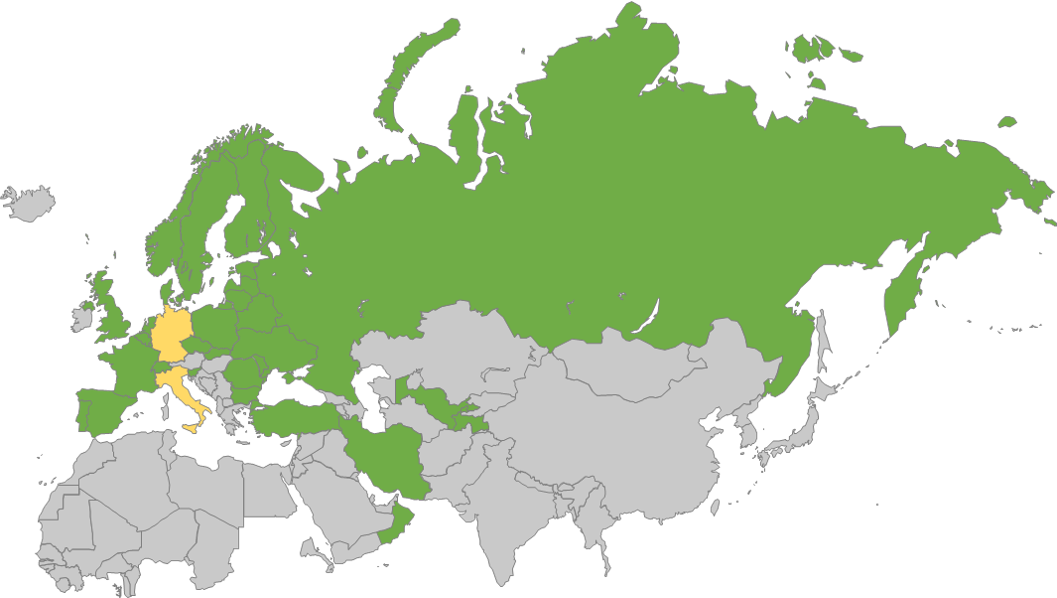A document for international road transportation
In general, a consignment note (CMR) for road transportation serves the purpose of proving that the goods have been transferred, accepted and, that the goods are in good condition. It serves as a contract between sender, carrier and consignee and it must be issued prior to the physical transport operation. A legally valid CMR must be available on the spot and must be signed by the sender as well as by the carrier. Its evidentiary function is crucial as a liability of all parties involved. The consignment note for road transportation is differentiated into three types:
- The CMR: This document is used for international transport operations
- The National Consignment Note: It is applied exclusively for national transports
- The Mixed Consignment Note: It can be used as international or a national consignment note (DTLF, 2018, p. 73)
The CMR was issued by the United Nations in May of 1956. It applies when the sender and the recipient are situated in two different countries and at least one country has signed the convention. It is not applicable if the carriage is performed under the terms of any international postal convention, in funeral consignments or for furniture removal. The CMR must include three original copies for every party involved, signed by the sender and by the carrier. The CMR contains 26 fields and includes information such as:
- Date and place where the CMR is issued
- Name and address of the sender, carrier and consignee
- Place of taking over the good as well as place and date of delivery
- Description of the goods and the packing method
- Number of packages and its gross weight
The CMR Process
The carrier is responsible for any loss, damage or delay to a CMR up until its delivery. When the goods are handed over, the carrier must check the number of packages, their marks and their numbers. Furthermore, he is obliged to check the apparent condition of the goods and their packaging. On the contrary, the sender is liable for any loss or damage that the carrier suffers 10 when the details were incorrect (UNECE, 1956). The objective of the next figure is to describe the transaction process and its parties involved:

Figure 1: Sequence Diagram CMR (based on UNECE, 2018, p. 6)
In the first step, the Transport Service Buyer provides the relevant consignment instructions to the sender. The sender usually issues the CMR and gives the goods to the carrier. As an alternative, the carrier can issue the CMR by himself. The sender and the carrier must both sign the CMR when the goods are handed over. Any discrepancies between the goods received versus the consignment instruction must be reported in the document. Then, the carrier ships the goods and its consignment note to the place of delivery. If necessary, the carrier provides the information to the authorities when crossing a border. At the place of delivery, the consignee checks the condition of the package and signs the CMR as a proof of delivery. In the end, the sender receives the confirmation of the receipt (UN Economic Commission for Europe, 2018).
The e-CMR on the Rise
In February 2008, the e-CMR protocol was issued by the UNECE, which requests that the CMR should be managed electronically. It facilitates the existing paper-based process with an electronic recording and handling of data. The protocol states that the e-CMR shall be considered to be equivalent to the CMR. Instead of a manual signature, the e-CMR is authenticated by a reliable electronic signature that ensures its link with the electronic consignment note. Reliability means that the electronic signature is:
- Uniquely linked to the signatory
- Capable of identifying the person who signed the e-CMR
- Under the sole control of the signatory
- Linked to the data of the documents so that any subsequent change of the data is detected
In addition to the authentication of the signature, the e-CMR must be accessible in a neutral database by any party entitled to it. That is also important for the documents supplementing the electronic consignment note. The e-CMR enters into force in a country after its ratification of the protocol (UNECE, 2008). Currently, 29 countries have signed protocol:

Figure 2: Map of contracting parties (UNECE, 2021)
The map shows that a few significant countries in Central Europe are missing. However, Germany and Italy are currently working on ratifying the convention (UNECE, 2021). The pressure to ratify this protocol will even increase in the next couple of years due to the recent eFTI initiative by the European Commission.
The transformation of road freight
In the beginning of 2020, the European Commission adopted a new EU regulation on electronic freight transport information (eFTI) which states that by 2025 every party involved must accept electronic freight documents. It should promote the use of digital technologies for electronic information exchange related to the transport of goods, harmonize IT systems and standardize digital solutions. Authorities must accept electronic transport information and use a common data set for the processing of these documents. Operators need an eFTI platform certification and present the information in a machine- and human-readable format to the authorities. This regulation will drive the vision of a fully digitalized logistics industry in the European Union (European Commission, 2018b, p. 12 – 13).
Sources:
- (2018). Towards paperless transport within the EU and across its borders—Sub-gorup 1: Electronic transport documents.
- European Commission. (2018b). REGULATION OF THE EUROPEAN PARLIAMENT AND OF THE COUNCIL on electronic freight transport information.
- (1956). Convention on the Contract for the International Carriage of Goods by Road (CMR). 46.
- (2008). ADDITIONAL PROTOCOL TO THE CONVENTION ON THE CONTRACT FOR THE INTERNATIONAL CARRIAGE OF GOODS BY ROAD (CMR) CONCERNING THE ELECTRONIC CONSIGNMENT NOTE.
- (2018). BUSINESS REQUIREMENTS SPECIFICATION (BRS) e-CMR.
- UN Economic Commission for Europe. (2018). Business Requirements Specification (BRS) e-CMR.
- (2021). UN Transport Agreements and Conventions—Additional Protocol to the CMR concerning the electronic consignment note (e-CMR). https://www.unece.org/trans/maps/un-transport-agreements-and-conventions-27.html

